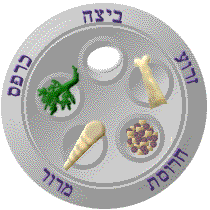On Passover, there are a lot of symbols used to remember the Exodus from Egypt. One is called a Seder plate. Below are the symbols and what each represents about the Passover holiday.

Mortar or Charoset (in Hebrew): A mixture of apples, nuts, spices, and wine or grape juice. It symbolizes the mortar that the Jewish people used to build and keep the bricks together when they were slaves of Pharaoh in Egypt. During the Passover Seder, the Charoset is eaten with Matzah, Karpas, and the Bitter Herbs.
Roasted Egg or Beitzah (in Hebrew): The egg symbolizes a few things. The roundness of the egg resembles the earth and life which constantly is moving in a circle. An egg is the traditional food for mourners and was brought to Jerusalem after the destruction of the temple. Since Passover is celebrated during the spring season, the egg represents spring time.
Bitter Herbs or Maror (in Hebrew): The bitter herbs symbolize and helps us to remember the bitter times the Jews had to experience while slaves of Pharaoh in Egypt. The common food used on a Seder plate is horseradish. Some people use the horseradish in the jar while others will use fresh, and slice pieces from the horseradish root.
Shankbone or Zeroa (in Hebrew): This is considered the Passover offering. The Pashcal lamb was sacrificed as the Passover offering the night the Jewish people were fleeing Egypt from Pharaoh.
A Green Vegetable or Karpas (in Hebrew): Karpas symbolizes the spring time. It also symbolizes the bitter times the Jews had to endure in slavery. It is believed the stem of the lettuce is bitter and as it grows up from the ground, the leafy part begins to taste less bitter.
The Karpas is also used to dip into the salt water at the beginning of the Seder.
Salt Water: The salt water is placed on the table as part of the Passover Seder. This symbolizes the slaves sweat and tears while they were slaves of Pharaoh in Egypt.

